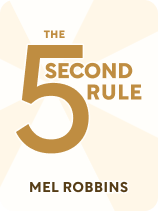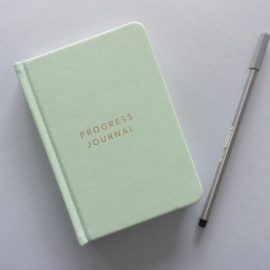

This article is an excerpt from the Shortform book guide to "The 5 Second Rule" by Mel Robbins. Shortform has the world's best summaries and analyses of books you should be reading.
Like this article? Sign up for a free trial here.
What is the book The 5 Second Rule about? What are the main takeaways of the book?
In The 5 Second Rule, Mel Robbins offers a solution to procrastination and dissatisfaction with your life. She says that counting down from five to one over the course of five seconds is the key to taking control of your life.
Read below for a brief overview of The 5 Second Rule book.
The 5 Second Rule by Mel Robbins
Do you feel stuck and dissatisfied with your life? Do you struggle to take steps toward self-improvement, live in the moment, or overcome procrastination? If so, life coach and motivational speaker Mel Robbins offers a solution. In her book The 5 Second Rule, Robbins explains how you can assert agency over your life using a single method: counting down from five to one over the course of five seconds and acting when you reach one. This practice encourages you to work towards your goals without letting overthinking or hesitation immobilize you.
While Robbins isn’t a licensed therapist or psychologist, her personal experiences with anxiety and ADHD inform her approach to mental health. Robbins uses a combination of her own coping techniques, testimonials from others, and neuroscientific research to support her claims that the 5 Second Rule can help you in every aspect of your life.
Part 1: Background on the Rule
According to Robbins, you can use the 5-Second Rule to:
- Jump into action
- Be bold and follow your gut
- Control impulsiveness
The First Test of the Rule: Getting Out of Bed
Now that we’ve addressed the broad uses of the Rule, let’s explore how Robbins specifically argues you should first use it: to make yourself get out of bed 30 minutes earlier than you normally would.
(Shortform note: Using this as the first test of the Rule might not be effective for people who struggle to get out of bed for medical reasons—for instance, due to fatigue-related conditions like narcolepsy and chronic fatigue syndrome. For these people, no amount of counting down from five will help them overcome their medical condition. If this sounds like you, you could pick a different first test for the Rule—for instance, motivating yourself to send a difficult email or motivating yourself to work out.)
Robbins explains that there are multiple benefits to making this your first test of the Rule. First, she points out that there are few factors affecting the test, which means there’s no room for excuses if you fail. Success depends only on your alarm clock sounding and you implementing the Rule: Therefore, if you don’t get out of bed, it’s because you didn’t act when you reached one, and not because something else got in the way.
(Shortform note: When you get rid of external factors to blame for your inaction and take full responsibility for your choices, you may find that you feel worse about yourself if you fail—you might even chastise yourself and tell yourself that you should be doing better. In The Now Habit, Neil Fiore explains that many people try to motivate themselves to act by saying that they “should” be better. This implies that they’re a bad person if they don’t do the right thing, making them feel ashamed; and the shame drains their motivation, making it harder for them to act. Instead of using harmful “should” language that triggers shame, Fiore recommends telling yourself that you “choose to” get out of bed early, or that you “want to” get out of bed early.)
Second, Robbins sees getting out of bed early as a preview of how it feels to apply the Rule. Using the Rule and compelling yourself to act is difficult at first but becomes easier over time. By using the Rule to get out of bed early, you can feel what it’s like to push through this period of struggle (getting out of bed) and reach the point where it’s easy to continue (when you’re up and moving).
The Science Behind the Rule
Robbins also discusses the science behind the Rule. Why does it have such a powerful effect on the brain and help us to fight procrastination, hesitation, and harmful impulses? In other words: Why does it work? She states the science behind the Rule works in two ways:
- Using the prefrontal cortex to challenge patterns
- Creating new patterns
Part 2: Putting the Rule Into Practice
Now that we’ve explored the basics of the Rule and how to use it, Robbins discusses how to put the Rule into practice (in combination with other methods) to stop procrastinating, spend more time on your passions, and manage anxiety.
Stop Procrastinating
Robbins addresses how, in conjunction with other methods, the Rule can help you overcome two types of procrastination
- Procrastinating on daily tasks
- Procrastinating on life changes.
Spend More Time on Your Passions
Once you stop waiting to make life changes in general, you can begin working toward one specific change: spending more time on your passions, and the activities that excite you most. Robbins advises using the Rule for this because it’s often difficult to set aside time for your passions.
According to Robbins, the Rule can help you get past your overthinking and take concrete steps to follow your passions. For example, if you have dreams of working in a big art museum but you currently live in a small town with few artistic resources, you may feel unprepared to move away even though you know it’s what you need to do to follow your desired career path. In this case, you can use the Rule to get yourself to look up apartment options in bigger cities with lots of career opportunities in the arts.
Use the Rule to Regulate Anxiety
In addition to helping you stop procrastinating and start spending more time on your passions, Robbins explains that the Rule (when combined with other methods of coping) can help you calm yourself when you feel fearful and anxious. Robbins’ strategies for managing anxiety are:
- Managing mild anxiety using gratitude
- Reframing the intense anxiety as excitement
- Visualizing the future to avoid anxiety

———End of Preview———
Like what you just read? Read the rest of the world's best book summary and analysis of Mel Robbins's "The 5 Second Rule" at Shortform.
Here's what you'll find in our full The 5 Second Rule summary:
- Why counting down from five to one will help you assert agency over your life
- The different ways you can use the 5-Second Rule
- How to figure out what your passions are and work toward them






